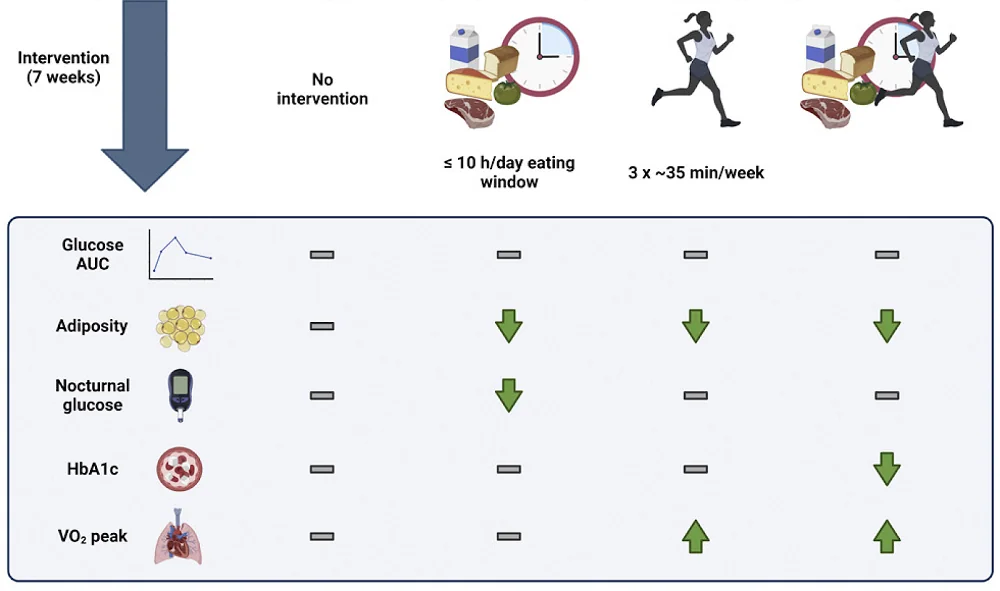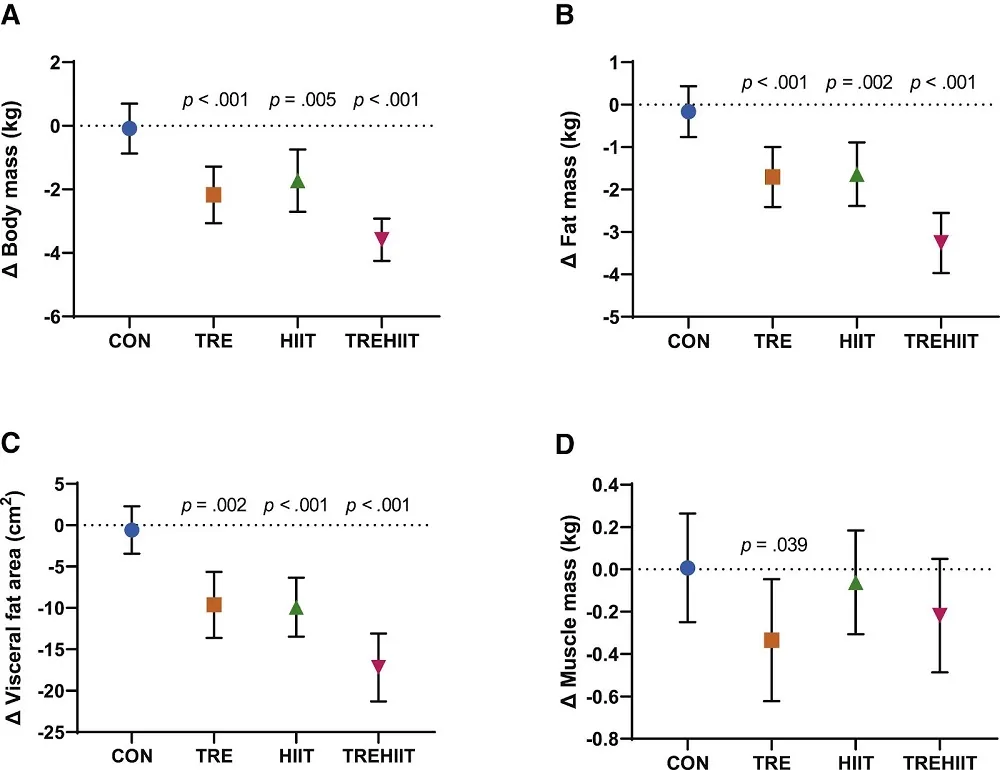Scientists have shown that both high-intensity interval training (HIIT) and time-restricted eating improve metabolism in healthy overweight women, with their combination providing the biggest effect [1].
Which one is better?
Good dietary habits and physical activity are currently our best options for living longer and healthier lives. In recent years, two interventions have been gaining popularity – intermittent fasting and HIIT. Some swear by one, and some by the other, and there is already considerable scientific evidence of their health benefits. However, how these two interventions compare to each other and to their combination, in terms of metabolic and cardiovascular outcomes, has remained an open question. The results of a new randomized, controlled trial published in Cell Metabolism seem to provide some answers.
Female-only design
The study was female-only and included 131 women of reproductive age (mean age of 36), randomly assigned to four study groups: time-restricted eating (TRE), HIIT, TRE+HIIT, and a control group. While sex bias might limit a study’s generalizability, we now know that men and women have somewhat different metabolisms. Moreover, women had been underrepresented in medical trials until recently, so a lot of our scientific knowledge might be skewed towards male biology. Obesity and insulin resistance in women also have some sex-specific implications, including accelerated reproductive aging and increased risk of adverse pregnancy outcomes.
In this study, TRE is basically intermittent fasting attuned to diurnal circadian rhythms, with eating confined to an 8- to 10-hour window during the day. While TRE does not limit the total number of calories or food composition, people on TRE often spontaneously reduce their energy intake, leading to some weight loss [2]. TRE is also known to improve insulin sensitivity in men with prediabetes [3] and even in healthy non-obese people [4].
HIIT is characterized by short, repeated bouts of high-intensity aerobic exercise separated by low-intensity breaks. It has been shown to improve cardiorespiratory fitness and insulin sensitivity in high-risk populations [5]. HIIT also seems to be much more effective in inducing weight loss than continuous moderate-intensity workouts [6]. A combination of TRE and HIIT has already been shown to attenuate fat mass gain and some adverse metabolic changes in mice on a high-fat diet [7], but human data is limited.
Combine them if you can
This new study brings mixed results. The combination treatment had no effect on the primary outcome, glucose area under curve (AUC), which shows how well someone tackles post-meal glucose spikes. However, participants in all study groups experienced significant weight loss, and both TRE and TRE+HIIT induced improvements in secondary glycemic control outcomes. While TRE alone was able to reduce levels of nocturnal glucose, TRE+HIIT improved levels of glycated hemoglobin (HbA1c), a primary metric of long-term blood glucose.

TRE+HIIT also led to a significant improvement in peak glucose levels. This metric has been gaining in importance, including in the context of aging, as two of the drugs shown to reliably extend lifespan in mice, acarbose and canagliflozin, work by flattening post-meal glucose spikes.
As expected, both TRE and HIIT led to some weight loss, but the combination treatment clearly showed a cumulative effect. TRE induced mild muscle mass loss that was partially rescued in the TRE+HIIT group. HIIT, both alone and in combination with TRE, produced noticeable improvement in maximum oxygen capacity (VO2max), a metric of physical fitness.

The researchers note that most previous studies have shown bigger benefits for already unhealthy people. In this study, most of the participants, despite being obese, showed normal glycemic values at baseline. This might be the reason why the primary outcome was not achieved.
While the study was mostly well-designed, one detail pops out: mean BMI at baseline was the lowest in the TRE+HIIT group (31.4) and the highest in the control group (33.1). Such discrepancies can potentially contaminate the results, though there is no evidence that this happened in this study.
Conclusion
This randomized, controlled trial confirms the benefits of both intermittent fasting and HIIT on certain metabolic outcomes in generally healthy overweight women. Both interventions are beneficial on their own, but women who practice them together, according to this study, are rewarded with a cumulative effect. Future research will confirm the likely possibility that this is just as true for men.
Literature
[1] Haganes, K. L., Silva, C. P., Eyjólfsdóttir, S. K., Steen, S., Grindberg, M., Lydersen, S., … & Moholdt, T. (2022). Time-restricted eating and exercise training improve HbA1c and body composition in women with overweight/obesity: A randomized controlled trial. Cell Metabolism, 34(10), 1457-1471.
[2] Kang, J., Ratamess, N. A., Faigenbaum, A. D., Bush, J. A., Beller, N., Vargas, A., … & Andriopoulos, T. (2021). Effect of time-restricted feeding on anthropometric, metabolic, and fitness parameters: a systematic review. Journal of the American College of Nutrition, 1-16.
[3] Sutton, E. F., Beyl, R., Early, K. S., Cefalu, W. T., Ravussin, E., & Peterson, C. M. (2018). Early time-restricted feeding improves insulin sensitivity, blood pressure, and oxidative stress even without weight loss in men with prediabetes. Cell metabolism, 27(6), 1212-1221.
[4] Xie, Z., Sun, Y., Ye, Y., Hu, D., Zhang, H., He, Z., … & Mao, Y. (2022). Randomized controlled trial for time-restricted eating in healthy volunteers without obesity. Nature communications, 13(1), 1-10.
[5] Maturana, F. M., Martus, P., Zipfel, S., & Nieß, A. M. (2020). Effectiveness of HIIE versus MICT in improving cardiometabolic risk factors in health and disease: a meta-analysis. Med. Sci. Sport Exer, 53, 559-573.
[6] Viana, R. B., Naves, J. P. A., Coswig, V. S., De Lira, C. A. B., Steele, J., Fisher, J. P., & Gentil, P. (2019). Is interval training the magic bullet for fat loss? A systematic review and meta-analysis comparing moderate-intensity continuous training with high-intensity interval training (HIIT). British journal of sports medicine.
[7] Vieira, R. F. L., Muñoz, V. R., Junqueira, R. L., de Oliveira, F., Gaspar, R. C., Nakandakari, S. C. B. R., … & Pauli, J. R. (2022). Time‐restricted feeding combined with aerobic exercise training can prevent weight gain and improve metabolic disorders in mice fed a high‐fat diet. The Journal of Physiology, 600(4), 797-813.




